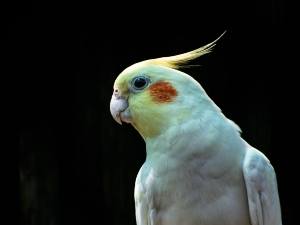
Fungi can affect humans, walls, houseplants, and even your pet cockatiel, and fungi can affect your pet cockatiel’s beak as well.
This article is a look into all you need to know if your cockatiel starts to develop a beak fungus.
Table of Contents
Cockatiel beak fungus:
We know that fungi grows in damp spaces but it can also grow on your bird’s beak too. It may be rare but it does happen.
Here is what you need to know about it:
Fungal infection in your bird:
Your bird’s fungal infection may be caused by a variety of different types of fungi namely cryptococcus fungi, ringworm, or Malassezia yeast.
The type of fungi that mainly attacks bird beaks is yeast.
The fungal infections that your birds can become infected with are similar to the ones that attack human fingernails and toenails, one example of a human fungal infection is athlete’s foot.
The fungal infections that birds get usually grow on the corners of their beaks where the top and the bottom beak join together.
The infection usually looks like a yellowish crust over the area and if left untreated the bird will develop small round crusty balls in this area that are the size of a millet seed.
This ailment can only be accurately diagnosed by your vet who will take scrapings of the fungus and view it under a microscope with high magnification.
Treatments:
If the bird’s fungal infection is well established then it can be more difficult to treat, however, it can still be controlled and eventually treated.
Over-the-counter fungal creams like Clotrimazole, Terbinafine, and Hydrochloride Butenafie can be used for your bird’s fungal infection if applied consistently.
The vet can also give you a prescription for a stronger fungal medication that you can’t get over the counter.
When using this treatment on your bird’s beak be sure to avoid the bird’s feathers and avoid allowing the salve or cream to get into the bird’s nares when applying it to the bird’s beak.
Also, avoid trying to pull the infection off of your bird’s beak. You can try to wipe it off to see if the fungal infection is actually food, but if it is not food, and you pull it off, then it can start to bleed as it is rooted in the skin.
You would, however, need to have it taken care of, if left alone then it can cause the bird’s blood supply to go systemic.
It is said that swabbing the area for two or three days with apple cider vinegar will kill the yeast but it is still recommended that you simply take the bird to the vet for an examination and treatment.
Tea tree oil is also sometimes used because of its ability to kill a variety of bacteria, viruses, and fungi but it is poisonous and it will be especially poisonous to your small cockatiel so we do not recommend it.
Prevention:
If your bird has a fungal infection at its beak then you would need to clean and disinfect your bird’s feed bowls, drinkers, and the aviary overall. Keep the bird clean and dry to prevent infection.
You would also need to take care not to become infected yourself as infections can be spread from humans to birds and from birds to humans.
If you enjoyed this article then you may also be interested in other bird related articles. Here are some articles that you may be interested in: Why Does My Bird Sleep In His Food Bowl, How To Clean A Parrot Beak, Bird Rubbing Beak On Perch, Pigeon Diarrhea Home Remedy, Why Do Birds Rub Their Beaks On Each Other?, Why Is My Budgie’s Poop Green And Watery, Why Is My Cockatiels Beak Peeling

